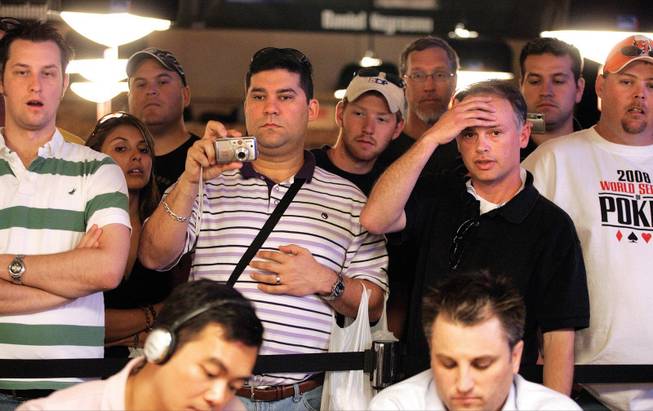
Spectators watch an early round in the World Series of Poker. Hundreds of thousands of dollars in prize money has been awarded, and the tournament continues.
Wednesday, June 11, 2008 | 2 a.m.
If You Go
- What: World Series of Poker
- Where: The Rio
- When: Through July 14 (Main event resumes Nov. 9 after a 117-day hiatus)
- Admission: Free for spectators
Las Vegas Sun History Project
Sun Archives
- Undaunted by early losses, Raymer counts on skill (6-03-2008)
- Bringing players back into game (5-09-2008)
Beyond the Sun
If the size of the fields at the World Series of Poker is an indication, interest in no-limit Texas hold ’em tournaments continues to run high.
The turnout for no-limit hold ’em events at the World Series, taking place through July 14 at the Rio with the championship final table set for November, has been exceeding last year’s figures.
The no-limit fields have also been skewing younger and less experienced, reflecting no-limit poker’s unceasing popularity among the new breed of players that has driven the game’s growth in recent years.
World Series events featuring limit games or forms of poker other than hold ’em, meanwhile, have generally been attracting an older, more experienced crowd and in some cases having a drop-off in the number of entrants.
The recently concluded limit Texas hold ’em tournament, for example, carrying a $1,500 buy-in, attracted 883 entrants. The tally was down from 910 players in the same event in 2007 and 1,069 players in 2006.
The downward trend stands in stark contrast to the situation before 2003, when World Series of Poker limit hold ’em events routinely drew more entrants than no-limit events, according to World Series spokesman Nolan Dalla.
From the middle of the 1980s, when California legalized hold ’em, and throughout the 1990s, limit hold ’em was the dominant form of poker spread in public card rooms, Dalla pointed out. While it was nearly impossible to find a no-limit cash game in most card rooms back then, today limit tournaments are rarities.
The winner of this year’s $1,500-entry limit hold ’em tournament, Jimmy Shultz of Charleston, S.C., was playing in his first World Series event. Shultz, who earned $257,049, said he would donate 25 percent of his win to the Charleston Fire Department.
The $2,500-entry half Omaha high-low split/half 7-card stud high-low split tournament tends to attract players who appreciate the nuances of those games rather than the raw excitement and brute force of no-limit hold ’em, according to Dalla.
Four players at the final table were 44 or older, a makeup typically not seen at a no-limit tournament final table. Farzad “Freddy” Rouhani, 44, a native of Iran who lives in Germantown, Md., won the $232,911 top prize.
The $2,500-entry no-limit hold ’em event that concluded Monday night, however, featured one of the least experienced final table lineups ever in the World Series. All nine players were competing at their first World Series final table, and four of the nine had never cashed in at a World Series event.
Duncan Bell, a 32-year-old poker pro from Vancouver, took first place ($666,697), finishing atop a field of 1,395 entrants. The turnout represented an 8.1 percent increase compared with last year’s field of 1,290.
The international flavor of the World Series was evident in the tournament, with players from 12 countries finishing in the money: Denmark, Switzerland, Belgium, Canada, England, China, France, Germany, Romania, Russia, Scotland and the United States.
The $10,000 world championship 7-card stud tournament, which also concluded Monday night, generated a field of 158 players, many of them top-level professionals. The event drew 180 last year, when the buy-in was only $5,000.
Eric Brooks of Philadelphia won the tournament’s $415,856 top prize, beating a tough final table that included Las Vegas pros Minh Ly and Erik Seidel and veteran Vasili Lazarou. Brooks said he would donate 100 percent of his winnings to the Decision Education Foundation.
One-table satellites.
Single-table satellites for the World Series are conducted all day at the Rio in a room just across the hallway from the main tournament room. The single-table satellites, which award tournament buy-in chips that can be used for entry into World Series events, have various structures.
Here is a rundown:
• Single-table satellites with buy-ins of $125, $175 and $225 provide players with $1,000 in tournament chips, and blinds increase every 15 minutes. The $125 satellites award two $500 tournament chips and $120 cash to the winner; the $175 satellites award three chips and $120 cash; and the $225 satellites award four chips and $120 cash.
• Single-table satellites with buy-ins of $275 and $325 provide players with $1,500 in tournament chips, and blinds increase every 20 minutes. The $275 satellites award five chips and $120 cash; and the $325 satellites award six chips and $120 cash.
• Single-table satellites with a $525 buy-in provide players with $2,000 in tournament chips, and blinds increase every 20 minutes. They award 10 chips and $120 cash.
• Single-table satellites with a $1,030 buy-in provide players with $5,000 in tournament chips, and blinds increase every 20 minutes. They award 20 chips and $150 cash.

Join the Discussion:
Check this out for a full explanation of our conversion to the LiveFyre commenting system and instructions on how to sign up for an account.
Full comments policy